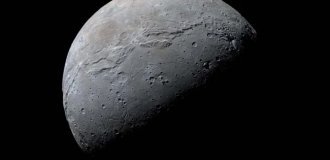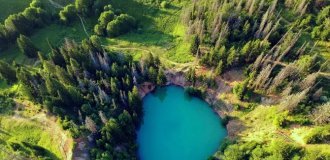Knife made of volcanic glass. Obsidian knife (54 photos)
Since ancient times, humanity has sought to make their work easier with the help of various devices. One of the first tools was a knife. Until people learned about metal, stones and obsidian served as materials for its production.

Until people learned about metal, stones and obsidian served as materials for its production. A knife made of volcanic glass was widely used for ritual and everyday purposes by primitive tribes. It was not just an auxiliary tool and an effective weapon, but also demonstrated the status of a man, personifying his courage and strength.

Obsidian is an igneous rock consisting of volcanic glass that has undergone rapid cooling of molten rocks.

Natural glass of volcanic origin, which is formed due to the very rapid cooling of lava, is called obsidian. There is a legend that the unusual stone first came to Europe thanks to the Roman Obsidia, hence the name. According to another version, the name of the stone comes from the Greek word “obsis”, meaning spectacle. It is known that mirrors were made from black obsidian.


Physical properties
When describing the physical properties of volcanic glass, the following characteristics are noted: the rock has a massive structure, completely glassy with rare inclusions of microphenocrystals; the color and pattern of the stone depend on microinclusions of magnetite, fawn spar, iron oxides, etc.; transparency depends on the inclusions, its degree varies from opaque to transparent (or translucent); composition is variable (range from rhyolite to basalt glass): silicon dioxide – 75%, water – less than 1%; silky, glassy shine; the fracture is sharp-edged, large conchoidal; there is no cleavage; fragile; amorphous.


Types of obsidian
rhyolite - its composition resembles granite;
Gabro - contains inclusions of pyroxene grains;
porphyry - a bright red variety of andesite;
diorite - formed on the basis of feldspar crystals, reminiscent of granite;
trachyte is a glassy, rough variety.


The composition of quickly hardened lava and the conditions for the formation of volcanic glass affect the color of the material:
Snow. One of the most beautiful varieties. On a general black or dark brown background, slightly blurry white spots resembling snowflakes are visible.
Rainbow. It contains clearly visible layers of blue, red, and green shades. The succession of colors looks especially beautiful when cut. It is also called peacock tail or midnight lace.
Black. The trade name in the United States is rock jet or black Nevada diamond. Has a deep pure black color. Tears of Apache. A variety of black obsidian is rounded discharge.
Black and red. Characterized by alternating red and black colors. The second name for this banded species is mountain mahogany.
Iridescent. Obsidian, overflowing with tiny gas and liquid inclusions, gives a golden or silvery effect.
Sometimes there is a multi-colored version: bluish-blue, red, green or rainbow.
One of the most beautiful varieties with a pearlescent tint was discovered in Armenia. Rare species include green Montana jade, transparent aquamarine obsidian with a greenish tint, and dark purple strombolite.
Obsidian Knife - Earth Flame

Deposits The mineral is found almost all over the world. There are such deposits in Mexico, USA, Russia, Hungary, Slovakia, Italy, Iceland, Scotland, Ethiopia, Nicaragua, Georgia, and Armenia.

Ancient knife
A knife made of horn and volcanic glass was a cult object and was used in the ritual of human sacrifice among the Aztecs. It was flat, double-edged, and leaf-shaped. Manual processing left uneven spots on it, but this did not in any way reduce its ability to cut flesh easily and evenly.


The length of the weapon could reach 30 cm, and the width - 6 cm. The handle, as a rule, was made of hard wood, horn or bone
and animals. Sometimes it was made of stone. The blade was secured using specially brewed glue from scales and bones or using animal tendons or plant shoots. There was a technology for melting tendons.


Stone products
Archaeological scientists believe that the use of obsidian began about eight thousand years ago and was due to the properties of the material:
lasting;
splits well into layers;
On chips it forms sharp cuts.

It was widely used for the manufacture of a whole range of cutting and piercing devices: axes, knives, scrapers, arrowheads, spears, etc. The metal replaced obsidian, but not in all cultures. The Indians of South America did not know ore mining; for many centuries they used a knife made of volcanic glass. The rituals of sacrifice and embalming were not complete without it. In terms of sharpness, such weapons were much superior to their metal counterparts.


The spread of knives was facilitated by trade relations between countries. Merchants transported luxurious, ornate items throughout the world. It was prestigious to have such a work of art; it spoke of the status and wealth of the family. In addition to tools, jewelry, mirrors, and household items were made from obsidian.


Knives
The obsidian knife still finds its connoisseur. Modern technologies offer materials that are completely unique in their qualities for the manufacture of household utensils, including cutting tools. But natural glass is unsurpassed in beauty.

A knife made of volcanic glass is made using ancient technologies. Use appropriate materials and tools. All such modern knives are divided into three groups:



The first category includes souvenir products. Although such products can be used quite well. Fishermen and hunters buy them with pleasure. At sub-zero temperatures, wet tackle begins to freeze to the metal blade. A knife made of volcanic glass does not have this drawback; moreover, it cuts perfectly, does not become dull, and only fails if it breaks. Another plus is that these are relatively cheap knives.


The second group includes knives made as jewelry. Old technology is not always suitable, so it is often improved. The sizes of knives depend on the wishes of the customer. The decorated handles are so elaborate that it is simply impossible to use such products. Stones with various inclusions are selected for production - this improves the appearance of the weapon, but reduces the quality of the blade. How much a knife made of volcanic glass costs is determined by the master. It all depends on the complexity of production and the value of the decorating parts.


The third group includes products created using modern technologies. Polishing the glass deprives the weapon of its characteristic chips and narrows the blade, which is why the quality of the knives suffers. The handle of this type is more convenient and practical than its jewelry counterparts, but due to the fragility of the blade, it is more of a souvenir than a tool.




Modern use
Modern medical knowledge allows surgeons to perform very delicate operations (plastic surgery, ophthalmology). Nanotechnology requires the use of the thinnest blade. Today, a knife made of volcanic glass is widely used for these purposes. It depends on the thinness of the blade. The tip of the knife, or rather its cutting edge, can be only 0.02 microns thick. A thin incision heals faster. .
[img]https:
//cn15.nevsedoma.com.ua/photo/735/120_files/775ac99b7d764106eddd3482059c76b6773c4fb9071122.jpg[/img]
Of course, modern technologies make it possible to produce thinner cutting tools. Diamond scalpels are only 0.003 microns thick and are more durable and stronger than obsidian scalpels. But high prices of one or more thousand dollars do not contribute to their widespread distribution.

To make the handle of such a scalpel, hardwood, usually maple, is taken. The blade is attached to it using epoxy resin. This manufacturing technology allows the instrument to be heat treated in an autoclave without any damage.

One scalpel can withstand up to 20 operations. The disadvantage is the fragility of the knife - it breaks under lateral pressure. One more thing: no two tools are the same. Manual production does not allow making the size and shape of the blade absolutely identical.

Such a tool is also in demand in cooking. Today, chefs have more than just metal knives in their hands. Ceramic products became widespread. Knives (Chinese, German, Japanese) have proven themselves to be reliable professional tools. In terms of their physical properties, they resemble obsidian blades.

Manufacturing technology
Making a knife from volcanic glass is carried out in three stages:
Processing the workpiece with a hammer. The workpiece itself should be twice the size of the final tool. With a strong and precise blow at an angle of 90°, the material is split so that a flat, even surface is formed. The edge will be sharp and can be used for cutting.
To give the blade a certain shape, the chip needs to be processed a little. To do this, you need to “shape” the blade with bone or very hard wood. This type of work requires patience, time and accuracy.
Finishing the blade using the squeezing method. Bark (or other cushioning material) is laid out on the “anvil”, a knife is placed on it and small flakes (from its underside) are carefully broken off with a sharpened stick or bone. This gives the blade a flatter shape and ensures its sharpness.

The handle is made of horn or wood. The blade is attached with glue; you can secure it with tendons or thin straps. Such a tool can be used to cut rope or skin game.

There is another quite popular obsidian knife called the "Heart of Pele". This is an example of a traditional ritual weapon of the indigenous Indians of South America.
The triangular double-sided blade with a sharp tip is attached to a graceful curved wooden handle. The blade is made of transparent obsidian of a reddish hue with black linear inclusions. Product length - 22.5 cm, width - 3 cm, weight - 80 grams. This beautiful handmade piece can be used as a ritual item and as a decorative element.

Chinese knives made of volcanic glass are offered in large quantities as souvenirs. They are not as exquisite as the one-piece pieces made by the masters, but, nevertheless, they can be an excellent gift for a man.

Advantages
An obsidian blade has better cutting properties than a steel blade. Does not require any special care. Does not crack, is not subject to destruction during operation. Does not fade, does not lose its natural color and polish. In addition to practical purposes, such a knife can serve as a wonderful gift, a decorative element, or be used as an object of ritual.

Flaws
All volcanic glass products are very fragile. Any impact or lateral pressure may cause the blade to break. The blade must not be exposed to hypothermia or heat. But with careful handling, a knife can serve for many years without losing its ability to cut perfectly.
Obsidian butcher knife.

Obsidian, dart tip

In addition to obsidian, agate can be used in modern stone products.



Aga?t is a mineral, a cryptocrystalline variety of quartz. It is a fine-fiber aggregate of chalcedony with
o layered texture and banded color distribution. It is a simple silicate with numerous elemental impurities.
Jewelers also call agate varieties of chalcedony without obvious layering, but with various inclusions that create a specific pattern: moss agate, star agate and others.
The origin of agates has not yet been fully elucidated. There are different theories about the origin of both the agate geodes themselves and the fine banding of the chalcedony layers in the agates.


Agate (from the Greek "ahates") - happy, good, useful. Agate is a type of chalcedony. The famous ancient scientist Pliny the Elder believed that the name of agate was given by the Sicilian river Achates.
The origin of agates is associated with volcanogenic rock complexes. Hot silica solutions penetrate into the casts of gas bubbles formed as a result of lava cooling.
Chalcedony and other mineral inclusions, precipitating from solutions, form agates. The oval shaped stones are called tonsils. If the tonsil is hollow, then it will be called a geode.
Chemical composition: silicon dioxide.


























